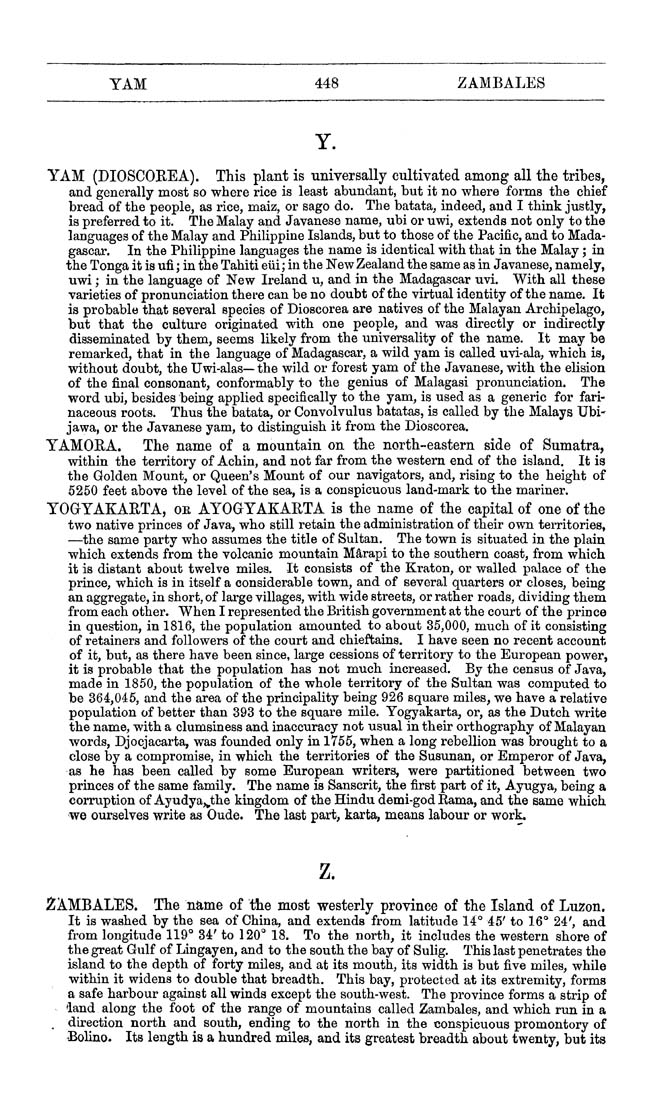YAM 448 ZAMBALES
Y.
YAM (DIOSCOREA). This plant is universally cultivated among all the tribes,
and generally most so where rice is least abundant, but it no where forms the chief
bread of the people, as rice, maiz, or sago do. The batata, indeed, and I think justly,
is preferred to it. The Malay and Javanese name, ubi or uwi, extends not only to the
languages of the Malay and Philippine Islands, but to those of the Pacific, and to Mada¬
gascar. In the Philippine languages the name is identical with that in the Malay; in
the Tonga it is ufi; in the Tahiti eiii; in the New Zealand the same as in Javanese, namely,
uwi; in the language of New Ireland u, and in the Madagascar uvi. With all these
varieties of pronunciation there can be no doubt of the virtual identity of the name. It
is probable that several species of Dioscorea are natives of the Malayan Archipelago,
but that the culture originated with one people, and was directly or indirectly
disseminated by them, seems likely from the universality of the name. It may be
remarked, that in the language of Madagascar, a wild yam is called uvi-ala, which is,
without doubt, the Uwi-alas— the wild or forest yam of the Javanese, with the elision
of the final consonant, conformably to the genius of Malagasi pronunciation. The
word ubi, besides being applied specifically to the yam, is used as a generic for fari¬
naceous roots. Thus the batata, or Convolvulus batatas, is called by the Malays Ubi-
jawa, or the Javanese yam, to distinguish it from the Dioscorea.
YAMORA. The name of a mountain on the north-eastern side of Sumatra,
within the territory of Achin, and not far from the western end of the island. It is
the Golden Mount, or Queen's Mount of our navigators, and, rising to the height of
5250 feet above the level of the sea, is a conspicuous land-mark to the mariner.
YOGYAKARTA, oe AYOGYAKARTA is the name of the capital of one of the
two native princes of Java, who still retain the administration of their own territories,
—the same party who assumes the title of Sultan. The town is situated in the plain
which extends from the volcanic mountain Marapi to the southern coast, from which
it is distant about twelve miles. It consists of the Kraton, or walled palace of the
prince, which is in itself a considerable town, and of several quarters or closes, being
an aggregate, in short, of large villages, with wide streets, or rather roads, dividing them
from each other. When I represented the British government at the court of the prince
in question, in 1816, the population amounted to about 35,000, much of it consisting
of retainers and followers of the court and chieftains. I have seen no recent account
of it, but, as there have been since, large cessions of territory to the European power,
it is probable that the population has not much increased. By the census of Java,
made in 1850, the population of the whole territory of the Sultan was computed to
be 364,045, and the area of the principality being 926 square miles, we have a relative
population of better than 393 to the square mile. Yogyakarta, or, as the Dutch write
the name, with a clumsiness and inaccuracy not usual in their orthography of Malayan
words, Djocjacarta, was founded only in 1755, when a long rebellion was brought to a
close by a compromise, in which the territories of the Susunan, or Emperor of Java,
as he has been called by some European writers, were partitioned between two
princes of the same family. The name is Sanscrit, the first part of it, Ayugya, being a
corruption of Ayudya,^the kingdom of the Hindu demi-god Rama, and the same which
we ourselves write as Oude. The last part, karta, means labour or work.
z.
ZAMBALES. The name of the most westerly province of the Island of Luzon.
It is washed by the sea of China, and extends from latitude 14° 45' to 16"* 24', and
from longitude 119° 34' to 120° 18. To the north, it includes the western shore of
the great Gulf of Lingayen, and to the south the bay of Sulig. This last penetrates the
island to the depth of forty miles, and at its mouth, its width is but five miles, while
within it widens to double that breadth. This bay, protected at its extremity, forms
a safe harbour against all winds except the south-west. The province forms a strip of
land along the foot of the range of mountains called Zambales, and which run in a
, direction north and south, ending to the north in the conspicuous promontory of
Bolino. Its length is a hundred miles, and its greatest breadth about twenty, but its
|








